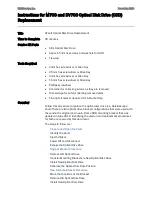
136
Copyright@2004~2014 Qsan Technology, Inc. All Rights Reserved.
Qsan Document – User Manual
services with less hard drives purchased upfront, which can significantly reduce your total
cost of ownership.
Scalability: storage pool can grow on demand.
When the storage pool (RAID group) has reached the threshold you set before. Up to 32
RAID sets can be added to the RAID group to increase the capacity on demand without
interrupting I/O. Each RAID set can have up to 64 physical disks.
Automatic space reclamation mechanism to recycle unused blocks.
The technology used here is called zero reclamation. When a thin RAID group is created, the
initialization process will try to fill out all the storage pool space with zero. This process will
run in background with low priority in order not to impact the I/O performance. This is the
reason why when there is no I/O traffic from the hosts, the hard drive LED will keep blinking
as if there are I/O activities. The purpose of zero reclamation is that when the actual user
data happens to have all zero in a basic allocation unit (granularity), the storage system will
treat it as free space and recycle it. Until the next time there is data update to this reclaimed
all zero basic unit, the storage system can swiftly return a basic unit from the free storage
pool because it’s already filled with zero.
An eco-friendly green feature that helps to reduce energy consumption.
Hard drive is the top power consumer in a storage system. Because you can use less hard
drives to achieve the same amount of work, this translates directly to a huge reduction of
power consumption and more green in your pocket.
Features Highlight
The following describes the comparison with Fat and Thin provisioning.
Write on demand or allocate on demand.
This is the most distinctive function in thin provisioning. You can see from the screenshots
below. Figure 1 shows there are two RAID groups created. "Fat-RG" is using traditional
provisioning without QThin enabled and its size is 1862GB. "Thin-RG" is QThin-enabled and
its size is the same.
Figure 1: No virtual disk is created
Let's create a Virtual Disk on each RAID group with the same size of 1000GB respectively in
Figure 2 and see what happen.
















































